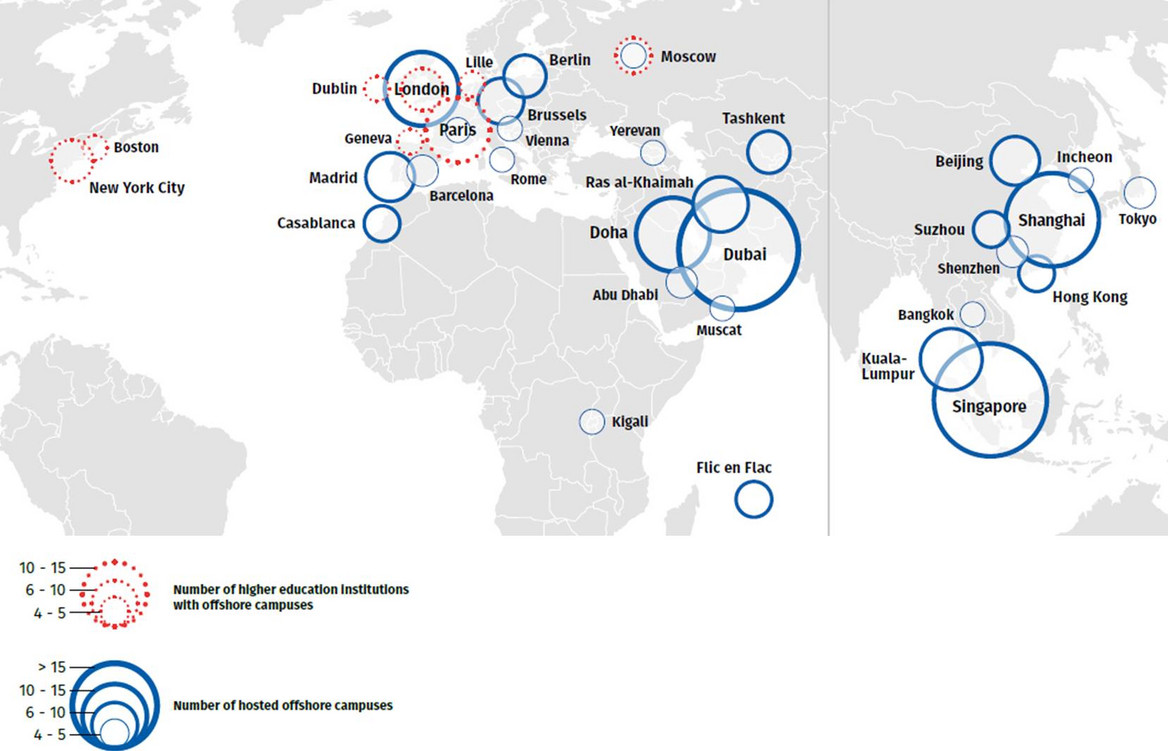Main Content
First Scientific Survey of University Offshore Campuses Published

Increasingly, universities are offering teaching not only on their home campus or online, but also in international branch locations. These "Offshore Campuses" are often designed as glamorous science cities that are marketed commercially. With the names of well-known universities as brands, they attract students. A scientifically sound overview of the number, location and origin of these institutions at city level has not been available until now. Now, the Junior Research Group "TRANSEDU" of the Leibniz Institute for Research on Society and Space (IRS) has presented an overall data collection.
Since 2018, the Leibniz Junior Research Group "Constructing Transnational Spaces of Higher Education. International Branch Campus Development at the Interface of Network and Territorial Embeddedness", or "TRANSEDU" for short, headed by Dr. Jana Kleibert, has been researching how universities and actors in the target countries plan and construct "offshore campuses", what motives and strategies are pursued in doing so, and what consequences result from this for the universities themselves, the students, and the locations where the campuses are constructed. A major milestone of the study was the creation of a uniform quantitative overview of the status and development of international university campuses. So far, comparable data has been published by higher education policy institutions such as the German Academic Exchange Service (DAAD), British Council or Campus France. However, their reports do not follow a uniform definition or scientific methodology and differ greatly in their statements. In addition, data has so far only been collected at the country level, not at the city level. Now a report entitled "Global Geographies of Offshore Campuses" is available, which presents the data collected by the Junior Research Group.
The criteria for an offshore campus are: There must be a physical (structural) presence of a foreign higher education institution at a location where university degrees can be obtained. According to this definition, there are currently 487 offshore campuses, with at least 14 more to be opened soon. The growth of Offshore Campuses has been consistently strong since 1989, with average double-digit growth until 2009 and lower growth in the last ten years. In total 58 Offshore Campuses have been closed, mainly in the last fifteen years. Mostly western universities are establishing offshore campuses, especially from the UK, France and the USA. French universities in particular are establishing large numbers of international branches (up to 34). Over time, however, there has been a diversification of sending countries. The share of the top five exporters has shrunk from 90% in 1990 to 70% in 2010.
The most important destination countries for offshore campuses are China (67), the United Arab Emirates (44), Singapore (19), Malaysia and Spain (17 each). However, branches are not only exported from the global North to the global South. European countries and cities are prominently represented both as importers and exporters of campuses, especially London and Paris. Overall, offshore campuses are strongly concentrated in a few large cities, especially Dubai (29), Singapore (19), Shanghai (15), London and Doha (both 12). In several cases, one city accounts for a significant proportion of all Offshore Campuses (Dubai accounts for 66% of all locations in the United Arab Emirates and London for 80% of all locations in the UK).
In some cases, clusters of offshore campuses are being developed as "transnational education centers", which are designed to attract foreign investment capital. These include Education City (Qatar), Dubai International Academic City (United Arab Emirates), EduCity Iskandar (Malaysia) and Uniciti Education Hub (Mauritius). Although only about 10% of all offshore campuses worldwide are located in these transnational education zones, these projects receive special global attention. "Transnational knowledge cities bring together great development visions, real estate industry return targets and the marketing of higher education as a global commodity like no other field," says project manager Jana Kleibert. "In our data we see many structures that we expected, such as the dominance of a few Western countries as exporters. But we also see that the expectations for such projects are sometimes too high. An offshore campus is not automatically a cash cow".

